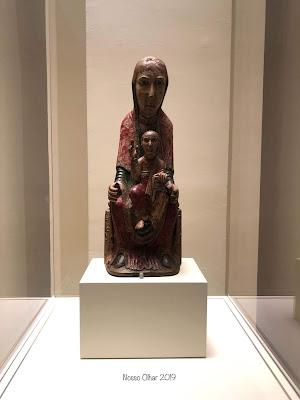Mais uma postagem sobre Bilbao,visitada em fevereiro. Um lugar imperdível é seu Museu de Belas Artes. Para marcar seus 110 anos, o museu preparou uma exposição chamada de ABC. A exposição alfabeto, diferente de outras que se baseiam em épocas e estilos, apresenta as obras por temas de A - Z.
Algumas dessas obras estão postas aqui.
One must visit place in Bilbao is its Museum of Fine Arts. To mark its 110th anniversary the museum is now presenting the exhibition ABC. The alphabet of the Bilbao Museum skips the traditional criteria for displaying works – chronologically or through schools of art and artists, and replaced it by an extended alphabet that includes 26 letters plus the "ñ" and the "ll" used in Spanish and the Basque digraphs "ts", "tx" and "tz".
 |
| Canal de Bruges/Bruges Canal Julián de Tellaeche -1922 |
 |
| Passagem de espelhos/ Passage of mirrors Maria Helena Vieira da Silva - 1981 |
 |
| Retrato do pintor Diaz Caneja/ Portrait of the Painter Diaz Caneja Jesús Olasagasti - 1930 |
 |
| São Francisco orando a Jesus crucificado/ Saint Francis in prayer before the Crucifix El Greco - 1585 |
 |
| A comunhão/The Communion Eugenio Lucas Velázquez - 1855 |
 |
| Ao redor do vazio/ Around the void Eduardo Chillida - 1964 |
 |
LL Lluvia Tranvia-lluvia / Tram-rain Juan Carlos Eguillor - 2002 |
 |
| Retrato do poeta Moratín/ Portrait of the Poet Moratín Francisco de Goya - 1824 |
 |
| M Mama/ Mãe Ofélia/ Ophelia Thomas Francis Dicksee - 1864 |
 |
| Ñ Ñabar/ Multicolorido O pária castelhano/ The Castilian Pariah Juan de Echevarría - 1917 |
 |
| B - Bestea Alteridade/ Otherness |
 |
| Elantxobe Antonio de Guezala - 1924 |
 |
| São Pedro em lágrimas/ Saint Peter in tears Bartolomé Esteban Murillo - 1650 |
 |
| U Urdin- Azul A aldeã com um cravo vermelho/ Country girl with a Red Carnation Adolfo Guiard - 1903 |
 |
| O barco azul/ The blue ship Mari Puri Herrero - 1985 |





















